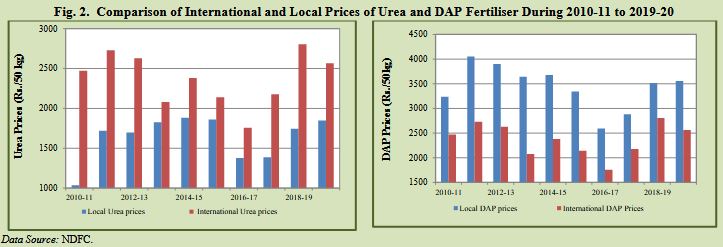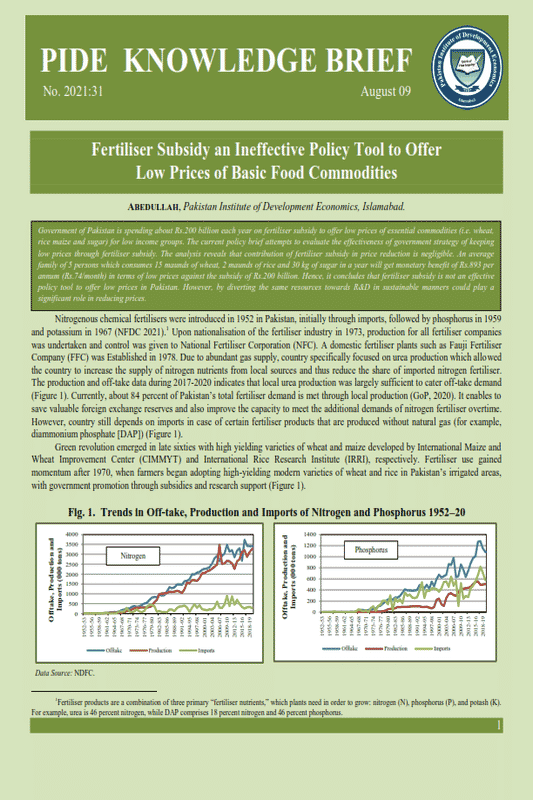
Pakistan Institute of Development Economics
- Home
Our Portals
MenuMenuMenuMenuMenuMenuMenu - ResearchMenuMenuMenuMenuMenuMenuMenu
- Discourse
- The PDR
- Our Researchers
- Academics
- Degree Verification
- Thesis Portal
- Our Portals
Fertiliser Subsidy an Ineffective Policy Tool to Offer Low Prices of Basic Food Commodities
Fertiliser Subsidy an Ineffective Policy Tool to Offer Low Prices of Basic Food Commodities
| Government of Pakistan is spending about Rs.200 billion each year on fertiliser subsidy to offer low prices of essential commodities (i.e. wheat, rice maize and sugar) for low income groups. The current policy brief attempts to evaluate the effectiveness of government strategy of keeping low prices through fertiliser subsidy. The analysis reveals that contribution of fertiliser subsidy in price reduction is negligible. An average family of 5 persons which consumes 15 maunds of wheat, 2 maunds of rice and 30 kg of sugar in a year will get monetary benefit of Rs.893 per annum (Rs.74/month) in terms of low prices against the subsidy of Rs.200 billion. Hence, it concludes that fertiliser subsidy is not an effective policy tool to offer low prices in Pakistan. However, by diverting the same resources towards R&D in sustainable manners could play a significant role in reducing prices. |
Nitrogenous chemical fertilisers were introduced in 1952 in Pakistan, initially through imports, followed by phosphorus in 1959 and potassium in 1967 (NFDC 2021).[1] Upon nationalisation of the fertiliser industry in 1973, production for all fertiliser companies was undertaken and control was given to National Fertiliser Corporation (NFC). A domestic fertiliser plants such as Fauji Fertiliser Company (FFC) was Established in 1978. Due to abundant gas supply, country specifically focused on urea production which allowed the country to increase the supply of nitrogen nutrients from local sources and thus reduce the share of imported nitrogen fertiliser. The production and off-take data during 2017-2020 indicates that local urea production was largely sufficient to cater off-take demand (Figure 1). Currently, about 84 percent of Pakistan’s total fertiliser demand is met through local production (GoP, 2020). It enables to save valuable foreign exchange reserves and also improve the capacity to meet the additional demands of nitrogen fertiliser overtime. However, country still depends on imports in case of certain fertiliser products that are produced without natural gas (for example, diammonium phosphate [DAP]) (Figure 1).
Green revolution emerged in late sixties with high yielding varieties of wheat and maize developed by International Maize and Wheat Improvement Center (CIMMYT) and International Rice Research Institute (IRRI), respectively. Fertiliser use gained momentum after 1970, when farmers began adopting high-yielding modern varieties of wheat and rice in Pakistan’s irrigated areas, with government promotion through subsidies and research support (Figure 1).
________________________________
[1]Fertiliser products are a combination of three primary “fertiliser nutrients,” which plants need in order to grow: nitrogen (N), phosphorus (P), and potash (K). For example, urea is 46 percent nitrogen, while DAP comprises 18 percent nitrogen and 46 percent phosphorus.
The comparison of local and international prices demonstrates that local prices of urea remained below than international prices during the last ten years but local prices of DAP indicates opposite trend during the same period. The low prices of urea in local market are mainly due to indirect subsidy on feedstock gas provided to urea industry. In addition to subsidy provided by federal government in terms of subsidised gas used in DAP fertiliser production, provincial governments also provide subsidy of Rs 500 per bag on DAP and SOP (GoP, 2020). If both federal and provincial government withdraw subsidy on DAP then difference between local and international prices shall widened. Because of low NP-ratio only Fauji Fertiliser Bin Qasim Limited (FFBL) produces DAP in the country.

Government is giving indirect subsidy to fertiliser sector by offering subsidised input such as (Natural gas) to keep the fertiliser prices low. The prime objective of fertiliser subsidy is to maintain the prices of essential food commodities such as wheat, rice and sugar in the affordable range for the poor segment of the society. The current policy brief is aiming to evaluate the effectiveness of fertiliser subsidy policy in achieving the objective of low prices of essential food commodities and cotton.
A major portion around 80 percent of gas supplied to the fertiliser industry is for feedstock. A price differential of Rs. 721/mmbtu between feedstock and fuel stock exists but economic survey further translates that this subsidy on gas appears in terms of Rs. 865 lower prices of urea bag[2] (GoP, 2020). This price differential between feedstock and fuel stock of gas accounts for Rs.150 billion per annum but this does not include the tax relief to the fertiliser industry (Planning Commission 2021). In addition to these subsidies government also provide subsidy of Rs.1194/bag on imported urea (GoP, 2019). The aggregate subsidy of the federal government to the fertiliser sector is more than Rs.200 billion per annum and subsidy given by the provinces are in addition to this (Planning Commission, 2021.
The retail price of urea bag was Rs. 1686 during 2020-21 with a subsidy of Rs. 865/bag on feedstock gas (GoP, 2020). A major share (65 percent) of this price (Rs. 1096/bag) is the cost of production and the remaining 35 percent (Rs. 590) is the profit which divides among different stake holders including production units (NFDC, 2021 & Planning Commission 2021). However, if subsidy on feedstock gas was withdrawn (Rs. 865/bag) then the selling price of urea would have increased to Rs. 2551/bag. This cost structure of the urea bag demonstrates that fertiliser companies are earning certain profit from the fertiliser subsidy rather than maintaining a “reasonable” threshold level of urea prices for the farmers.
Government also give subsidy on DAP (Rs.405/bag), equal to the contribution of gas in total cost of production. During 2020-21 average retail price was Rs. 4054 per bag (GoP, 2020). If there was no price incentive on feedstock gas in DAP production then retail price of DAP would have increased to Rs. 4459/bag.
If we compare the amount of subsidy on fertiliser with federal Public Sector Development Programme (PSDP) budget of Rs.650 billion allocated in 2020-21 then fertiliser subsidy of Rs.150 billion accounts for 23 percent of the current development envelop. However, if we add up other subsidies in terms of tax reliefs and provincial subsidies and incentives to the fertiliser industry then it accounts for more than Rs.200 billion in 2020-21 which is about 31 percent and 22 percent of Federal PSDP of Rs. 650 billion for 2020-21 and Rs. 900 billion for 2021-22, respectively. In 2020-21 fertiliser industry generated a cumulative net profit of Rs. 80.4 billion – more than half of the subsidy in terms of feed-fuel price differential.
____________________________
[2] One bag of Urea and DAP=50kg.
However, no serious attempt has been made to understand the role of indirect fertiliser subsidy to minimise the prices of essential food commodities and cotton in Pakistan. For this purpose, it is important to investigate the elements of cost of production and to identify the fertiliser contribution in total cost of production of these crops. The percentage contribution of different components of costs for different crops during 2019-20 is summarised in Table 1.

It is observed that land rent is playing a dominant role in cost of production of all crops and it varies from 24 percent in maize to 38 percent in wheat. The contribution of harvesting component is highest after land rent in all crops except rice where contribution of irrigation is highest (19 percent). The harvesting share of wheat is highest (18 percent) compared to all other crops. It is probably because wheat is cultivated on 80 percent cropped area in Rabi season and there is high competition for labour and harvesting machinery (harvester and thresher) to minimise the climatic risk. Moreover, rented machinery (harvester and thresher) is involved in the harvesting process. Fertiliser is the third largest component of production cost in wheat and cotton but it is largest contributing factor in case of maize.
The consumption of urea and DAP fertiliser in each crop is given in Table 2. The highest amount of urea (3.5 bags) and DAP (2 bags) is used in maize production. The hybrid seed of maize is highly responsive to fertiliser—motivating farmers to use high amount of fertiliser to achieve maximum yield.
Under the assumption, if all subsidy in terms feed-fuel differential in urea and DAP and subsidy of Rs. 500/bag on DAP and SOP provided by provinces is withdrawn and all the additional cost is transferred to the consumers then prices of wheat and maize will increase by Rs. 1.3/kg, Rs. 1.7/kg respectively, while prices of sugar and rice will increase by about Rs. 1/kg under the assumption that one kg of sugarcane produces 0.11 of sugar (Water footprints, 2021). However, highest increase is observed in case of cotton (Rs. 2.2/kg)-mainly due low yield (Table 2).

On an average a family of 5 persons consumes 600kg (15 maund) of wheat per annum and withdrawal of fertiliser subsidy will cost that family an additional amount of Rs.792/year and Rs. 66/month. Under the assumption that family also consumes 80 kg (2 maund) of basmati rice and 30kg of sugar each year then withdrawal of subsidy will cost that family an additional amount of Rs.76 and Rs. 24 per annum for rice and sugar, respectively. If we add up all these three costs then additional burden on the family will be of Rs. 893/annum. This is negligible amount compare to the total annual budget of the family but it consumes more than Rs. 200 billion (22 percent of PSDP) each year of the nation. Therefore, withdrawal of fertiliser subsidy will not affect the poor family at large because it is adding only Rs. 74/month in the total expenditure. However, diverting the same amount of resources toward R&D on sustainable basis could significantly contribute to develop innovations. The priority areas are development of production technologies (varieties and breeds), improvement of rural infrastructure and capacity building of stakeholders (training of plucking fruits and vegetables, packing and transportation) may help to enhance the productivity and value of agriculture produce. Higher productivity could lead to lower cost of production which could help consumers to enjoy low prices in the long run. Hence, increasing spending on R&D is an alternative and sustainable approach to improve food security among poor segment of the society.
REFERENCE
AMIS (2021). Agriculture Marketing Information System (AMIS). http://amis.pk/
GoP (2020). Pakistan Economic Survey 2020-21. Finance Division Government of Pakistan.
GoP (2019). Pakistan Economic Survey 2019-20. Finance Division Government of Pakistan.
NDFC (2021). National Fertiliser Development Centre (NDFC). www.nfdc.gov.pk/stat.html
Planning Commission (2021). Fertiliser Industry. From the Desk of Member, Planning Commission, Private Sector Development and Competitiveness.
Water Footprints (2021). https://www.qmul.ac.uk/geog/media/geography/docs/teachers/Global-average-water-footprint-teachers. docx#:~:text=It%20takes%20about%20175%20litres,gives%200.11%20kg%20of%20sugar



